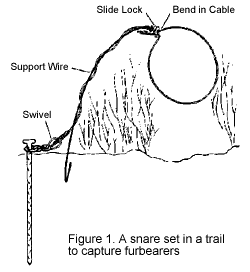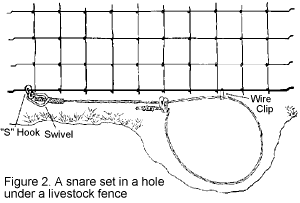Quick
Facts
|
 Snaring is a useful technique to capture animals that cause
economic loss, such as coyotes that kill livestock and beavers
that cut trees or plug irrigation ditches. Snaring also is
popular for harvesting surplus furbearers, one of our renewable
natural resources. Snares are effective for capturing target
animals, but may capture non-target animals such as deer and
dogs if used improperly.
Snaring is a useful technique to capture animals that cause
economic loss, such as coyotes that kill livestock and beavers
that cut trees or plug irrigation ditches. Snaring also is
popular for harvesting surplus furbearers, one of our renewable
natural resources. Snares are effective for capturing target
animals, but may capture non-target animals such as deer and
dogs if used improperly.
Snaring is the technique of setting a steel-cable loop in an animal's movement path to capture the animal by the neck or leg. Snares usually consist of a 2-1/2 to 10-foot long piece of galvanized aircraft cable containing a slide lock that forms a loop in the cable (Figure 1). Attach a swivel, which prevents twisting and breaking of the cable, to the end of the cable opposite the loop.
Snares present several advantages over steel leghold traps. They are light weight, compact, simple in function, affected little by weather, easy to set, low in cost, and offer a high degree of trapper safety. In a south Texas study, snares were 10 times more selective for target species (coyotes and bobcats) than steel leghold traps. However, snares can be a greater hazard to livestock and some non-target species may be killed.
Snare Preparation
New commercial snares and extension cables can be cleaned by boiling in detergent and hanging outdoors for a few months until they turn a dull gray. Snares also can be changed to a dull gray by boiling each dozen snares in 4 tablespoons of baking soda for one hour. Darker snares can be obtained by boiling in brown logwood crystals and dye. After boiling, keep snares clean of foreign odors. Wear clean gloves when handling and setting snares.
How to Set Snares
Snares designed to capture furbearers by the neck or leg are set directly in the center of the animal's movement path. Snares usually are held in an animal's movement path with one of several different support systems. One support that works particularly well can be constructed from a 36-inch piece of 12-gauge galvanized or 9-gauge soft wire. A "V" bend is made in the support wire about 4 inches from the end and driven into the ground with a notched rod to prevent the support from moving in the wind. The snare is wrapped around the support about three times and held in place by a "U" configuration formed in the upper end of the snare support. Bend the snare cable upward slightly, just inside the lock, so the snare loop is not closed by the wind (see Figure 1).
Attach snares to a solid object so captured animals cannot escape. A steel 1/2-inch diameter rebar, 24 to 30 inches long (depending on soil hardness), makes a good anchor. Attach snares to the rebar with a strong swivel to prevent tangling and breaking. Use a lead cable that is at least as strong as the snare cable to attach short snares to the rebar stake. Avoid using 9-gauge wire or several strands of 14-gauge wire to anchor snares to a rebar stake because they may bend back and forth, crystallize, and break. When used for beaver, snares also can be secured to a tree that is at least 6 inches in diameter or to the base of a large shrub such as a willow.

Snares set in holes under woven wire fences should be held in place about 1 to 2 inches from the fence with the snare support system described in Figure 1. The top of the snare can be as high as 3 inches above the bottom wire of the fence. Set the snare far enough away from the fence to prevent the lock from catching on the bottom wire of the fence. Hold the snares in place by clipping them to the bottom wire of the fence with a fine U- shaped wire such as a 1 1/2-inch piece of a paper clip that allows the snare to easily release (Figure 2). The bottom of the loop should be about 2 inches above the bottom of the hole or coyotes and foxes may be caught by a front leg. With either of the above snare support systems, anchor the snares to the heavy-gauge wire on the bottom of the fence. The upper wires on a woven wire fence usually are too weak to secure a snare.
Snares occasionally are placed in the field but left unset for one to two weeks. This placement allows trappers to quickly set snares when pelts become prime and reduces human scent at the site.
Snares usually are set in the form of a round or oval loop. A round loop that is 12 inches in diameter can form an oval loop that is about 14 inches high and 10 inches wide. The following round loop diameters and heights above ground are recommended when snaring furbearers (Table 1).
A 5/64- or 3/32-inch diameter galvanized aircraft cable is recommended for snaring coyotes, beaver, and raccoons. Foxes and bobcats can be captured in 1/16- to 3/32-inch-diameter snares.
| Table 1. A snare set in a hole under a livestock fence | |||
| Furbearer | Type of set | Round loop diameter (inches) | Height of bottom of loop above ground (inches) |
| Coyote | Trail | 9-12 | 10-12 |
| Coyote | Under Fence | 7-10 | 2 |
| Coyote | Leg Snare | 8-11 | 4 |
| Fox | Trail | 8-10 | 6-9 |
| Fox | Leg Snare | 8-11 | 4 |
| Bobcat | Trail | 8-10 | 6-8 |
| Raccoon | Trail | 8-10 | 3-5 |
| Beaver | Den, underwater | 8-11 | Cover bottom of loop slightly |
| Beaver | Dryland Trail | 8-11 | 2-4 |
| Beaver | Slide in water | 8-11 | Set bottom of loop 2 inches below water |
Where to Set Snares
Animals usually follow the easiest route through heavy cover. These routes, which generally consist of trails, are excellent locations to snare furbearers. Specific locations to set snares for individual species follow.
Beaver
Coyotes and Red Foxes
Raccoon
Checking Snares
Check snares regularly. Within any city limits or any areas annexed into a city, Colorado Division of Wildlife regulations require that snares be checked at least once daily unless mechanical means are provided to kill snared animals. In all other areas, snares must be visually checked at least once every other day unless mechanical means are provided to kill snared animals. However, all snares, especially those set near residential areas, should be checked once every 24 hours, preferably early in the morning, to increase the probability of releasing non-target animals unharmed and to minimize the duration of restraint.
Methods to Avoid Capturing Non-target Animals
Carefully select sites where snares are set to avoid capturing non-target animals.
Snares are likely to remain a legal harvest tool and a legal depredation control device if they are not misused. There is no need to make a set that has high potential for capturing non-target animals. For example, most coyotes can be captured anywhere within their home range, which usually averages 1 1/2 to 10 square miles in size. Thus, select areas where non-target animals will not be captured. Before setting snares, become familiar with state wildlife regulations. Learn the proper techniques and try to accompany a proficient snareperson while learning to set and check snares. By all means, THINK before setting any snare. Responsible trappers have an obligation to the wildlife species as well as other trappers, so do your best to avoid problems when snaring.
License Requirements
A furbearer
license is required to snare badger, gray fox, kit fox, swift
fox, beaver, marten, muskrat, mink, ringtail, long-tailed
weasel, short-tailed weasel, and bobcat. A small game or furbearer
license is required to snare coyote, red fox, raccoon, striped
skunk, spotted skunk, hognosed skunk, or opossum.
Publication #: 6.517
Service in Action 6.517, Cooperative Extension, Colorado State University. Published January 1988. Revised August 1993. Copyright 1993. For more information, contact your county Cooperative Extension office.
Colorado State University Cooperative Extension wildlife specialist and associate professor, fishery and wildlife biology.Disclaimer and Reproduction Information: Information in NASD does not represent NIOSH policy. Information included in NASD appears by permission of the author and/or copyright holder. More